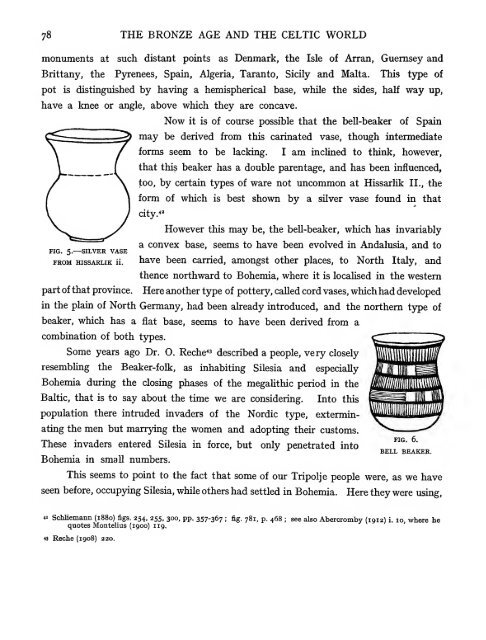The bronze age and the Celtic world - Universal History Library
The bronze age and the Celtic world - Universal History Library
The bronze age and the Celtic world - Universal History Library
You also want an ePaper? Increase the reach of your titles
YUMPU automatically turns print PDFs into web optimized ePapers that Google loves.
78<br />
FIG. 5.—SILVER VASE<br />
FROM HISSARLIK ii.<br />
THE BRONZE AGE AND THE CELTIC WORLD<br />
monuments at such distant points as Denmark, <strong>the</strong> Isle of Arran, Guernsey <strong>and</strong><br />
Brittany, <strong>the</strong> Pjnrenees, Spain, Algeria, Taranto, Sicily <strong>and</strong> Malta. This type of<br />
pot is distinguished by having a hemispherical base, while <strong>the</strong> sides, half way up,<br />
have a knee or angle, above which <strong>the</strong>y are concave.<br />
Now it is of course possible that <strong>the</strong> bell-beaker of Spain<br />
may be derived from this carinated vase, though intermediate<br />
forms seem to be lacking. I am inclined to think, however,<br />
that this beaker has a double parent<strong>age</strong>, <strong>and</strong> has been influenced,<br />
too, by certain types of ware not uncommon at Hissarlik II., <strong>the</strong><br />
form of which is best shown by a silver vase found in that<br />
city.""<br />
However this may be, <strong>the</strong> bell-beaker, which has invariably<br />
a convex base, seems to have been evolved in Andalusia, <strong>and</strong> to<br />
have been carried, amongst o<strong>the</strong>r places, to North Italy, <strong>and</strong><br />
<strong>the</strong>nce northward to Bohemia, where it is localised in <strong>the</strong> western<br />
part of that province. Here ano<strong>the</strong>r type of pottery, called cord vases, which had developed<br />
in <strong>the</strong> plain of North Germany, had been already introduced, <strong>and</strong> <strong>the</strong> nor<strong>the</strong>rn t5^e of<br />
beaker, which has a flat base, seems to have been derived from a<br />
combination of both types.<br />
Some years ago Dr. O. Reche« described a people, very closely<br />
resembling <strong>the</strong> Beaker-folk, as inhabiting Silesia <strong>and</strong> especially<br />
Bohemia during <strong>the</strong> closing phases of <strong>the</strong> megaUthic period in <strong>the</strong><br />
Baltic, that is to say about <strong>the</strong> time we are considering. Into this<br />
population <strong>the</strong>re intruded invaders of <strong>the</strong> Nordic type, extermin-<br />
ating <strong>the</strong> men but marrying <strong>the</strong> women <strong>and</strong> adopting <strong>the</strong>ir customs.<br />
<strong>The</strong>se invaders entered Silesia in force, but only penetrated into<br />
Bohemia in small numbers.<br />
FIG. 6.<br />
BELL BEAKER.<br />
This seems to point to <strong>the</strong> fact that some of our Tripolje people were, as we have<br />
seen before, occupying Silesia, while o<strong>the</strong>rs had settled in Bohemia. Here <strong>the</strong>y were using,<br />
4> SchUemann (1880) figs. 254, 255, 300, pp. 357-367 ; fig. 781, p. 468 ; see also Abercromby (1912) i. 10, where he<br />
quotes Montelius (1900) 119.<br />
43 Reche (1908) 220.







